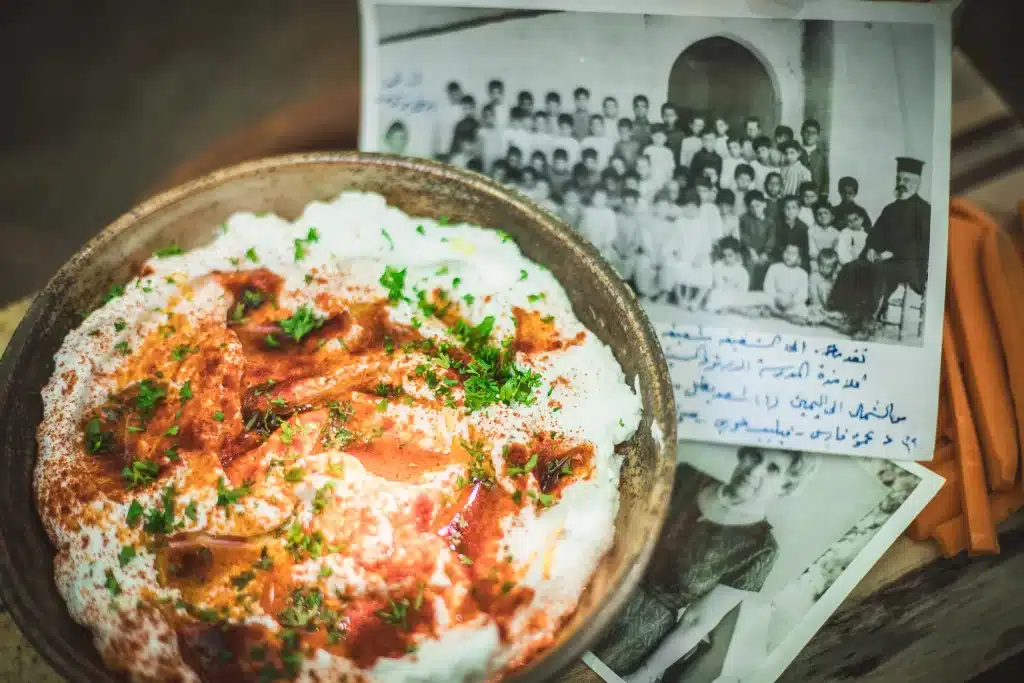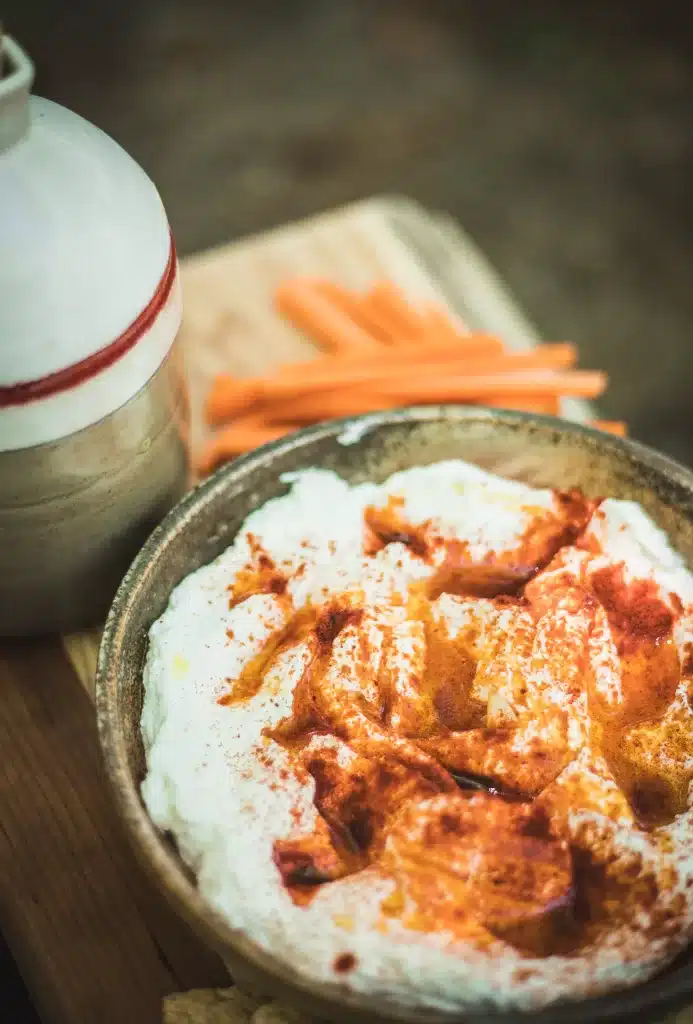
Labneh is a traditional soft cheese made from strained, whole-milk yogurt in many Middle Eastern cuisines. It is thick, tangy, salty, and a perfect foundation for dips made with herbs, spices, garlic, or lemon. When I was a child, I loved visiting the local Middle Eastern grocery store with my father to buy pita, bulk spices and teas, Syrian cheeses, and of course labneh. My dad, whose family is from Syria and Lebanon, grew up eating all these foods with his family and adored revisiting them as an adult. All of my siblings enjoy Middle Eastern food, but my dad and I are most passionate about exploring the cuisine and culture of our ancestors together.
A few years ago my grandmother gave me a recipe book that included many of the traditional family recipes my father grew up with. I immediately flipped to find the labneh my grandfather used to make and started to experiment with making my own. Now I find myself making a fresh batch of labneh almost every week. I enjoy making it for my father and hearing stories of his Sittie (grandmother) and the food she would serve at family gatherings.
This labneh recipe is simple, tangy, and delicious all on its own but you can also use it to make some amazing dips and spreads. I will include a few of my favorite ways to eat labneh below in addition to the base recipe of how to make it.
Labneh process + tips:
Labneh is made from straining Greek yogurt to make a thick and creamy spreadable cheese. Using organic, whole-milk Greek yogurt is very important here because it is one of only two ingredients so the flavor and quality will be apparent in the final result. Of course, you can use homemade yogurt (which is always delicious), but not everyone always has homemade yogurt in their fridge.
Straining Techniques:
1.) Add the yogurt to your cheesecloth or nut milk bag. Secure tightly and place in a fine mesh sieve over a bowl. Allow the yogurt to strain for a few days before seasoning and storing.
2.) Scoop the yogurt into a cheesecloth or nut milk bag, tie the cloth into a tight ball, and use the string to hang the ball of yogurt. You can hang the yogurt from the pulls of your kitchen cabinets, a nail on your wall, or even a wooden spoon placed over a large bowl. Make sure you have a bowl below your straining yogurt ball to catch the whey that will start to drip from it.
I let the yogurt sit at room temperature while it strains to let it ferment a little bit, which adds to the tangy flavor! Gravity will draw most of the moisture from your yogurt and you will be left with the whey and the yogurt solids. Combine the yogurt solids with salt to make labneh and use the whey in your smoothies or dressings.
Labneh Serving Suggestions:
“Labneh Toast”
My favorite way to eat labneh is also my grandfather’s favorite breakfast: labneh on sourdough with a drizzle of olive oil and a healthy shake of za’atar seasoning (or whatever seasoning you like).
Labneh Add-ins
Here are my favorite flavors to mix with labneh: garlic, lemon, parsley, mint, cumin, paprika, za’atar, sumac, harissa, and lots of organic extra virgin olive oil.
As a dip
Add garlic, olive oil, lemon, and harissa to the labneh (to taste). Dip veggies, sourdough discard crackers, or warm sourdough flatbreads in it for an amazing snack or appetizer.
Med Bowls
A combination of meat, veggies, and rice cooked with Middle Eastern herbs and spices. Add hummus, labneh, and curly parsley on top for a delicious and and easy weeknight meal.
As a substitute for greek yogurt or sour cream
In our house, we rarely have sour cream on hand, but we always have labneh. Instead of keeping lots of similar dairy products in my fridge, I like to keep Greek yogurt or labneh which is very versatile. I add it to soups, stews, dips, dressings, baked goods, sauces, pasta, and anything else you can imagine.


Ingredients and supplies:
1 lb plain, whole milk, yogurt
- I love to start with a traditional Middle Eastern yogurt that I find at my local Arabic bakery. If I can’t find this I will use an organic whole milk yogurt from my local grocery store. I have also made my own yogurt, which is delicious, but not something I do all the time.
Salt to taste
- Use a delicious natural mineral salt!
Fine Mesh Sieve
Cheesecloth
- I prefer to use a reusable nutmilk bag but you can also use cheesecloth
Wooden spoon
- My favorites are from estate sales but I have also found some beautiful ones from Crate&Barrel
Small bowl
- For mixing and serving
Kitchen twine
- I just use a basic, unbleached kitchen twine for such purposes
Traditional Labne Recipe
Ingredients
- 1 lbs thick, whole milk yogurt
- salt to taste
Instructions
- Spoon yogurt into your nut milk bag or cheese cloth
- Sinch up the bag or tie the cloth tightly using kitchen twine (please see notes on straining techniques above for additional methods)
- Place the yogurt bag in a fine mesh sieve over a small bowl. Store in the fridge for 1-2 days or leave on the counter if you want it to ferment a little bit for additional tangy flavor
- After a few days of straining the yogurt, it will be a very thick and spreadable labneh. There will be whey in the bowl which you can use in smoothies and dressings.
- Transport the labneh to a bowl and add salt to taste
- Serve or store as needed

Leave a Reply